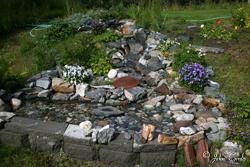
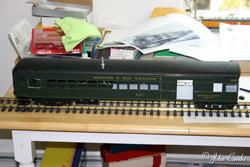
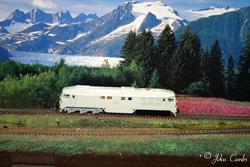
Wednesday, July 14, 2010
It's like a window into the past. A visit with historian and modeler Pat Durand always gave a glimpse of those early railroad days, bold and brash, gritty and dirty, spirited and driven. But before we got down to business today, Pat wanted to show me his backyard waterfall. The rocks came from as far away as Whittier and other pieces and parts had stories all their own. Occasionally Pat poked and prodded amongst the rocks in search of a hidden leak.
In the basement, Pat displayed a few of his latest projects. The Whittier Museum had commissioned Pat to create a G scale version of Brill #114 that graced the railroad from 1927 until 1954. Another project had an unusual twist - building an East German Railways Alaska Rail Link locomotive. After perusing a few other projects, Pat, ever the gracious host, led me upstairs for a bowl of Alaska Gumbo loaded with King Crab and shrimp.
 |
 |
 |
| The waterfall | In the works: G scale #114 | Alaska Rail Link |
Few remnants exist today from the railroad's early beginnings. However, Pat has been tracking them down one by one over the years. So today's activity would be a road trip specifically to bird dog a few of those in the vicinity of Wasilla. Our first stop was the Matanuska River overlook (N 61 38.014, W149 07.066) whose breathtaking beauty left me with a desire to drag a lawn chair to its rim, plop down and decompress for the rest of the afternoon. Pat pointed out the area where the railroad had dumped dilapidated freight cars to bolster the eroding river bank (see my hike with Jeff DeBroeck).
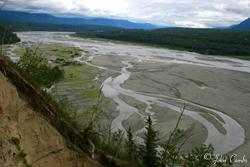 |
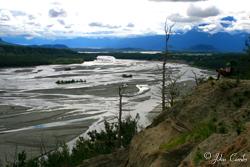 |
| Looking west | Looking east |
Next, we headed to the Eska Creek Bridge crossing (N 61 42.326, W148 54.973). The Eska mine itself was one of the largest coal producers in the Alaska Territory between 1917 and 1920 and averaged about 150 tons per day. This coal was used to fuel locomotives, as well as the power plants and pump stations located at Anchorage and Eska. The mine was used on and off until the 1960s. The train that picked up the coal had to cross the Eska Creek Bridge. Pat drove across the bridge and then parked off in the grass.
Some things in life do not age well. One example is Michael Jackson who suffered from one too many cosmetic enhancements. The Eska Creek Bridge, however, has held up incredibly well considering its age and is indeed a treasure in its own right. An up close inspection revealed each support and cross beam had been created from its own tree.
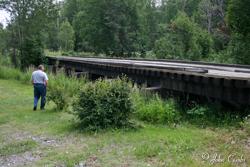 |
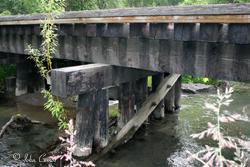 |
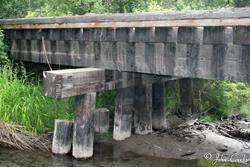 |
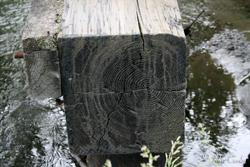 |
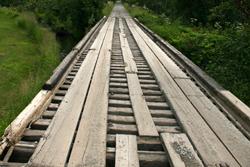 |
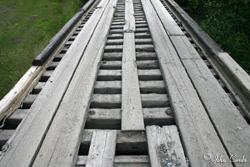 |
The road to the Eska site rose at a 6% grade. This was the
very same path the train traversed to pick up the coal from the mine. Although
Pat did not have a four wheel drive vehicle, he did a respectable job getting
us most of the way up. Unfortunately, we had to bail out towards the end.
The
overlook (N 61 43.851, W148 55.872) where we finally stopped was a beautifully
untamed stretch of land. I was even able to snag a few pieces of Eska coal
to
bring home with me.
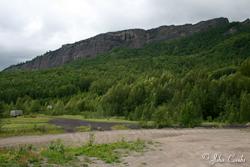 |
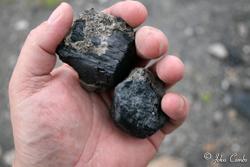 |
Next, we headed up to the Jonesville area, but again could only make it part way up due to impassible roads. We then made a brief stop at the backside of the mountain (N 61 44.716, W149 56.109) which led to the old strip mine pits.
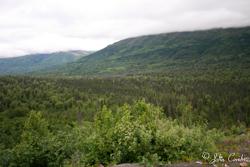 |
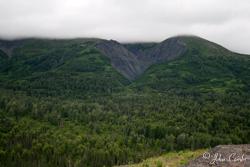 |
Continuing on our drive, Pat made a stop at a bridge where we could view the confluence of Chickaloon and Matanuska Rivers. Notice the color difference of the silty Chickaloon river as it slips into the Matanuska.
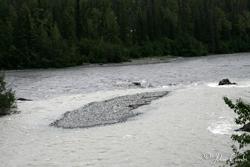 |
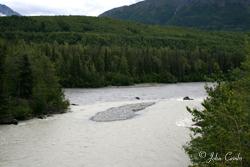 |
Our next stop was at the only remaining Howe truss bridge (N 61 47.207, W148 27.831) in Alaska. Of the bridge, Pay says, "The Alaska Engineering Commission built several Howe truss bridges on the Chickaloon Branch up the Matanuska River in 1916 to reach the coal mines on the Chickaloon River. At the mouth of Kings River where it enters the Matanuska River a wooden Howe Truss Bridge bridge was built just down stream of the current Glen Highway bridge. On the Chickaloon River there were two identical Howe Trusses built in the general location of the current road bridges across the Chickaloon. After the railroad pulled the track up in the 1920's these bridges were planked for highway traffic. The bridge measurements are 6.7m wide by 38.7 length. The two bridges remained in service until the Chickaloon Road was rebuilt along with new bridges and opened in 1982."
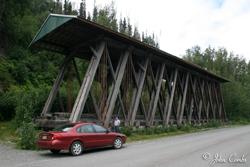 |
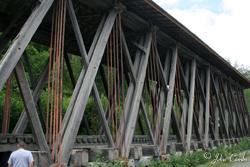 |
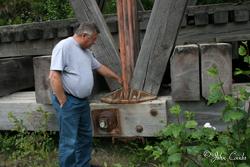 |
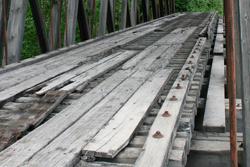 |
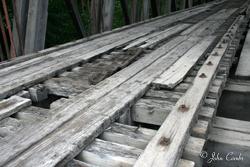 |
Our final stop was the Alpine
Historical Park (N 61 42.621, W148 52.619) whose sole purpose was
to preserve the heritage and culture of the early settlers who made up
the Sutton and Chickaloon
mining districts. It is located at mile 61.6 of the Glenn Highway in the Matanuska
Valley. We toured the Sutton Post Office, Old Timers Hall of Fame, mining
relics
and Eska coal washing plant. What I found most interesting was (obviously)
the photo displays showing the operations of the mines that interacted
with the
Alaska Railroad (1, 2,
3, 4, 5,
6).
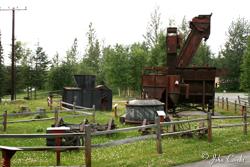 |
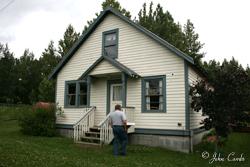 |
Big patches of blue sky made the drive back to Anchorage very
exciting. It brought a glimmer of hope that better weather might be heading
my way for the rest of my visit. While I was watching the blue sky, a highway
sign gave me a good reminder to keep my eyes on the road for possible moose
encounters. The state of Alaska has the highest number of moose-vehicle collisions
on its highways of anywhere in North America. Fortunately, only one half of
one percent of those accidents result in a fatality (human, not moose that is).
Even so, that 1,200 pounds of meat can sure do a number on your vehicle. My
wife and I had a very close call during our first visit back in 1986. We were
leaving Valdez around dusk. A moose exited the woods and stood on the road with
his front hooves on the white line of the berm. His dark body blended with the
darkness so I didn't see him until it was too late. Fortunately, our rental
car was so small that we passed safely under his head. If he had been 2-3 feet
more to my left I probably wouldn't be here telling you this story.
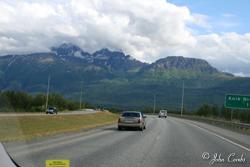 |
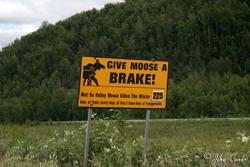 |
As I entered the downtown Anchorage area, I decided to grab a few more geocaches. I probably did about a half dozen before I stumbled upon a description for a larger sized cache. Now I have to tell you that larger sized caches in an urban area are pretty rare since it is very difficult to keep them hidden. However, this one was so clever that it could be hidden in plain sight. Would you like to see if you can find it?
Click here to view the scene at ground zero. See if you can find what doesn't belong.
If you think you see it then click here to see if you were right.
To view the contents of the cache then click here.
This cache was very clever since it was painted the exact same
color as the guardrail. Also, the owner added two "pretend" plastic
bolts to the lid to make it appear more like a piece of utility equipment. The
whole container was mounted to the guardrail's post using two strong magnets
glued to its base. Very nicely done!
The next geocache was next to Elderberry Park. Remember the song, "One Thing Leads to Another"? Up popped a southbound freight and I knew I just had to chase it down Turnagain Arm. As I approached the Potter Marsh area, a state trooper had pulled off to the side of the road alerting motorists of a moose nearby. Tourists were stopping to get a few photos. Priorities being what they were, I just snapped one out the window as I went by and continued my pursuit of blue and gold.
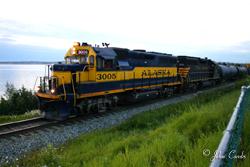 |
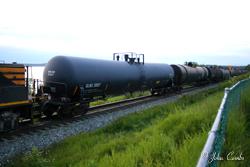 |
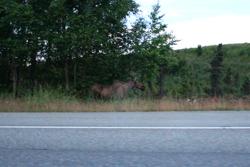 |
It's fairly difficult to take well-lit recognizable photographs of a speeding train at eleven o'clock at night. I did the best I could, but I must admit the chase was better than my photographs.
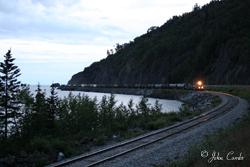 |
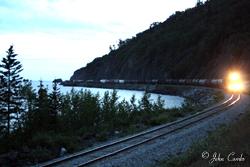 |
I decided to switch my little pocket camera over to high definition video mode. I wasn't expecting to get much out of this little guy, but capturing the moment on video [11.8MB] for just myself was all that was really important.
I was then struck with a wonderful idea - capture the freight train as it crossed TwentyMile bridge. This has always been one of my favorite photo spots so I was willing to make the long drive down the arm.
By the time I reached the pull off it was almost totally dark. I can't put into words the feeling of isolation I felt while crossing that road bridge in the dark of night, icy cold wind and enormous vehicles rushing past. Once I reached the end, I huddled on the bridge's cold railing and waited anxiously. And that is when the magic of Alaska swept in. In the distance I heard the song of a lonely wolf. Down in the river below a beaver swam quickly along the shore in search of something unseen. Over my shoulder I heard the faint call of an owl. Far in the distance I heard a familiar rumbling. It grew louder and louder until a dark shuddering locomotive emerged from the trees. My watch showed 12:20 AM. Although this video [30.8MB] will never win any awards, it will be an incredible reminder to me that foamer life is so beautiful.